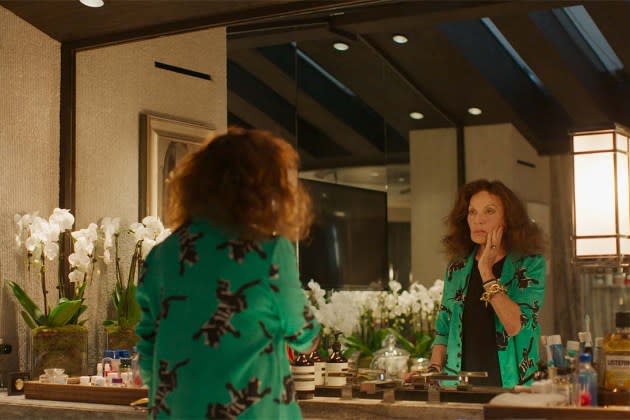‘Diane von Furstenberg: Woman in Charge’ Review: Iconic Designer Reflects on Her Life and Loves in Vivid Tribeca Opener

The engaging Diane von Furstenberg: Woman in Charge begins with a clip from David Letterman’s late-night show, where he introduces the designer with, “Welcome the woman who reinvented the dress.” He laughs and says, “Really? Reinvented the dress?” But that big claim isn’t entirely wrong. In the 1970s, von Furstenberg’s wrap dress was more than a trendsetter. Like the person who emerges in this largely first-person documentary, the dress became emblematic of a professional but sexy independent woman.
That much is history, retold by von Furstenberg in the film with wit and flair. The documentary’s strength, though, is its intimate look at her entire whirlwind life. The child of a Holocaust survivor, she became a jet-setter, a business tycoon and a philanthropist. She married a prince and then a mogul without ever losing her own identity.
More from The Hollywood Reporter
Much of what von Furstenberg says here she has said before, in interviews or in her two memoirs, notably The Woman I Wanted to Be (2014). But in retelling her story on screen, she has an inviting style full of the confidence and self-possession that is at the heart of her brand and that defines the documentary’s style. The film presents its subject in glittering terms, but it is also constantly fascinating, and gracefully directed in an unflashy manner by Sharmeen Obaid-Chinoy and Trish Dalton. (Obaid-Chinoy has won two Oscars for shorts and is set to direct Daisy Ridley in Star Wars: New Jedi Order.)
The least-known part of von Furstenberg’s story, backed by family photos, begins during her childhood in Brussels. She was born 18 months after her mother was freed from Auschwitz, emaciated and warned by doctors not to have children. Von Furstenberg credits her mother for the determination that has shaped her own life.
In her early 20s she married the rich playboy Prince Egon von Furstenberg and recalls the chilly reception his aristocratic German family gave his middle-class Jewish bride. In a line that captures her wry tone, she says, “When I went to the Furstenberg castle, I thought ‘Maybe they will poison me.'”
She was also beginning to design, creating wrap tops inspired by those that ballerinas wear to rehearse, but in bright jersey prints. In her account, fashion was merely a means of gaining independence, not a passion. She moved to New York, where her business flourished, and she and the endlessly philandering bisexual prince became the It couple of the moment. But she was soon over being part of a couple. “Divorce for me was freedom,” she recalls.
On her own, she hit Studio 54, and looking back acknowledges her free and easy sex life, in sync with the times but more glamorous than most. “I was with Warren Beatty and Ryan O’Neal on the same weekend,” she says. One friend says that von Furstenberg has always been unapologetic about her sexuality, but her own comments suggest something bolder: that she didn’t think there was anything to apologize for in the first place. “I was having a man’s life in a woman’s body,” she says, echoing an often-quoted remark of her own.
Throughout the documentary, some of her famous friends, including Hillary Clinton, offer brief remarks, mostly testimonials rather than revealing observations. Oprah Winfrey remembers that as a young reporter she saved up to buy a von Furstenberg dress. More objective voices, although used sparsely, offer useful context. The New York Times fashion critic Vanessa Friedman, says, “Diane’s dress exists in the middle of the history of women’s rights and women in the workforce and women finding their own voice.”
The wrap dress was also affordable, which gave von Furstenberg reach and made her a plausible role model. Her family is more revealing than her celebrity friends. Her daughter recalls a childhood left largely in the care of Diane’s mother, saying, “I don’t know if you want to use the word neglected or free.” Von Furstenberg admits that as a very young mother she probably didn’t have enough time for her two children, but that they were always in her heart.
More colorfully, she recalls turning down a proposed three-way with Mick Jagger and David Bowie. She considered it, she says, thinking “Well this is something I can tell my grandchildren about.” Obviously she told them anyway. The next thing we hear — in a juxtaposition that suggests the film’s smooth construction — is her grown granddaughter saying that turning those two down at the height of their fame was a “really epic” move.
Barry Diller, the chairman of IAC, to whom von Furstenberg has been married since 2001, speaks about their relationship, which goes back to the ’70s when he was head of Paramount Pictures. He recalls the freedom of that era, when everyone slept with everyone in any combination. They were nonexclusive lovers for several years, were apart, then together again.
His comments seem both honest and veiled. He acknowledges the public speculation that “it’s just a marriage of convenience,” but goes on to say that he and von Furstenberg know what their true relationship is. “And frankly, who cares?” what other people say. Von Furstenberg calls him her soulmate and says, “First he was my lover, then my friend. Barry is the consistent love in my life.”
While guarding their private lives is understandable in a glossy film, the doc could have used more details about how von Furstenberg rebounded from failures. Instead, it flies past the information that at one point her dresses oversaturated the market and she lost money. Later, after she has licensed away her name, we never learn how she took back agency or about the state of the company today.
Puffy though it may be, though, this absorbing documentary is easy to like as it presents a life and career worth celebrating.
Best of The Hollywood Reporter

 Yahoo News
Yahoo News 